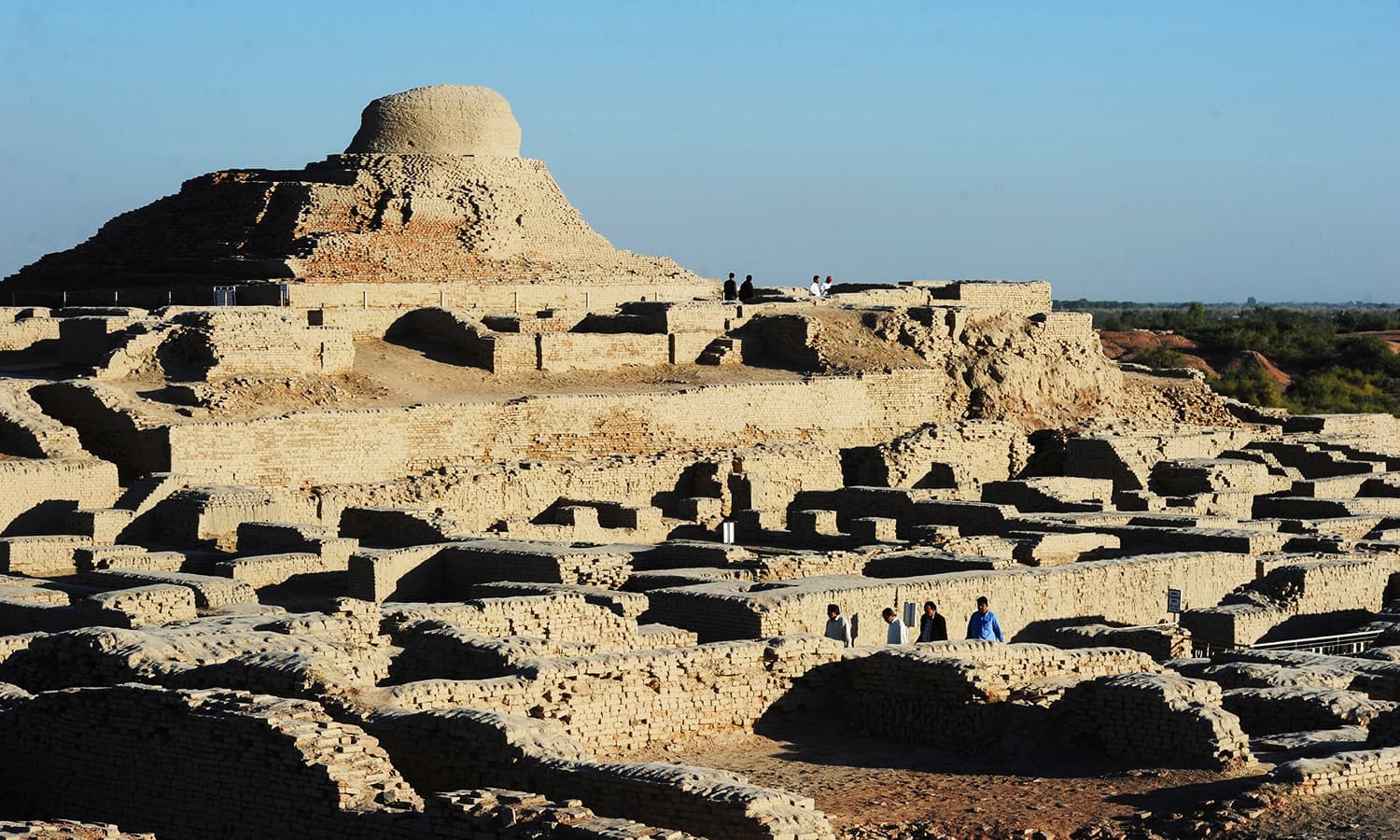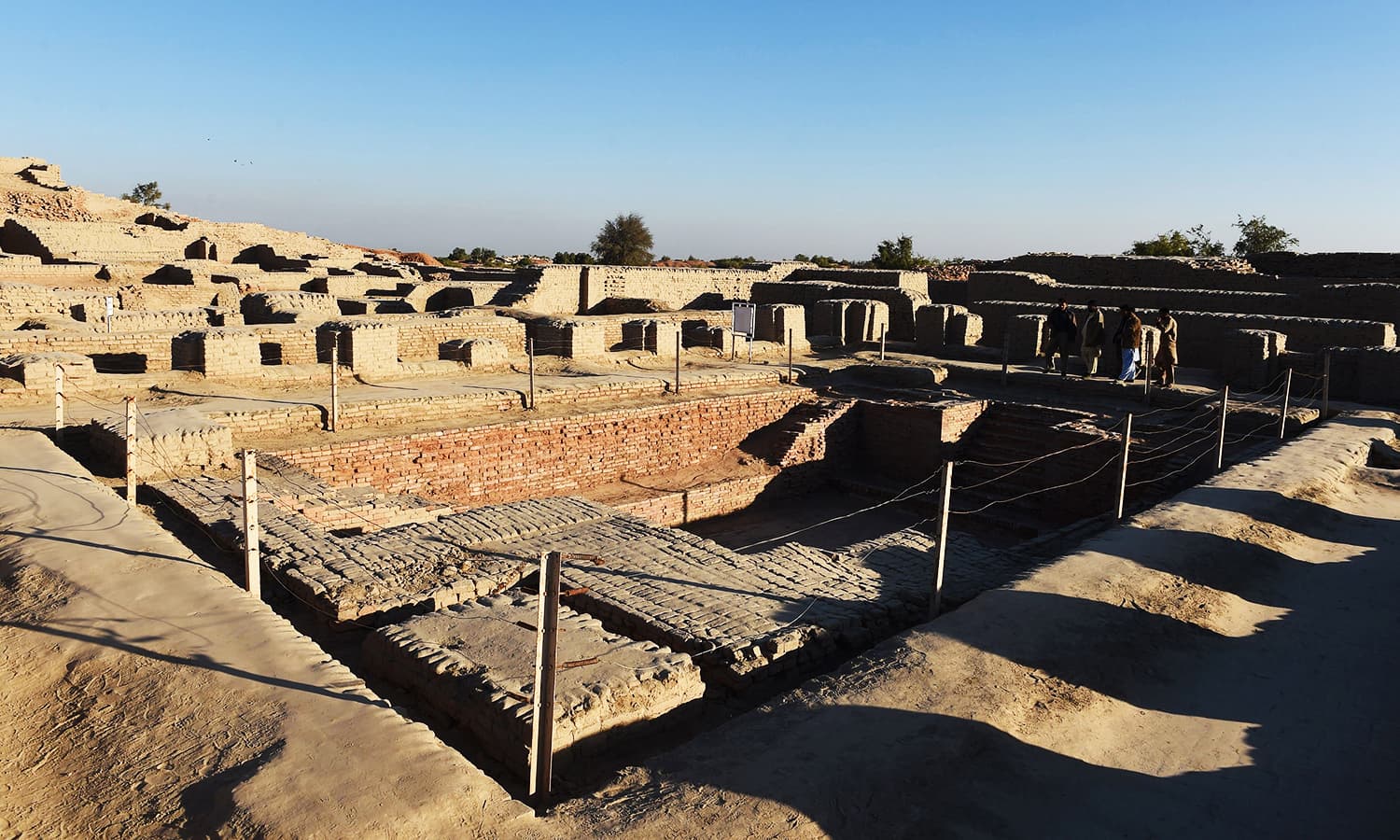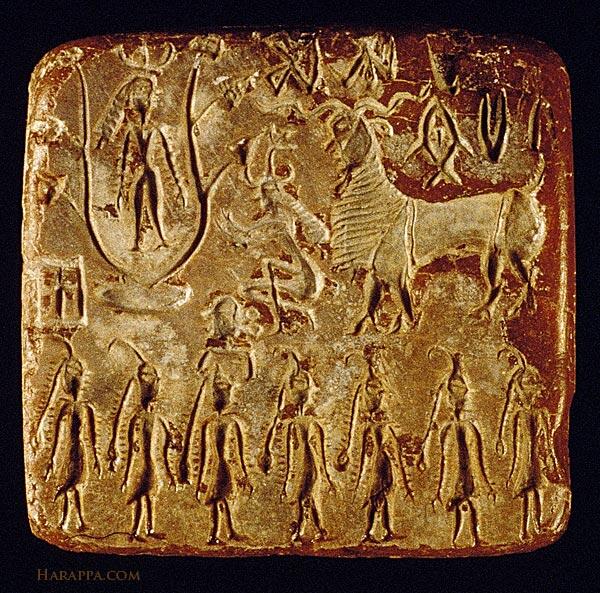How to install the app on iOS
Follow along with the video below to see how to install our site as a web app on your home screen.
Note: This feature may not be available in some browsers.
You are using an out of date browser. It may not display this or other websites correctly.
You should upgrade or use an alternative browser.
You should upgrade or use an alternative browser.
Mysteries of Mohenjo-Daro
- Thread starter ghazi52
- Start date
Indus Pakistan
BANNED

- Joined
- May 7, 2012
- Messages
- 20,487
- Reaction score
- 182
- Country
- Location
Why are you posting this in Pakistan history - the video says 'India'?10 Facts You Didn't Know About Mohenjo Daro......
Cherokee
SENIOR MEMBER

- Joined
- Jul 5, 2012
- Messages
- 6,722
- Reaction score
- -15
- Country
- Location
Why are you posting this in Pakistan history - the video says 'India'?
It doesn't change the fact that Mohenjo-daro is in Pakistan.
ghazi52
PDF THINK TANK: ANALYST

- Joined
- Mar 21, 2007
- Messages
- 101,683
- Reaction score
- 106
- Country
- Location
Why we are allergic to India.
We were part of India. Simple. Nobody can erase the past................

True.It doesn't change the fact that Mohenjo-daro is in Pakistan.
We were part of India. Simple. Nobody can erase the past................

Indus Pakistan
BANNED

- Joined
- May 7, 2012
- Messages
- 20,487
- Reaction score
- 182
- Country
- Location
Not in 5,000BCE. Even Burma was part of India in 1900s. When we were or not part of something depends on time. The issue is we were not part of India in 5,000 BCE as even the name India had not been coined, indeed the name comes from English language which would take another 3,000 years to be spoken. That is the point.We were part of India
ghazi52
PDF THINK TANK: ANALYST

- Joined
- Mar 21, 2007
- Messages
- 101,683
- Reaction score
- 106
- Country
- Location
Sadhus and Fakirs?
December 28th, 2016

Were there sadhus and fakirs in ancient Indus times?
It is not unlikely that ascetics, both men and women who had renounced their possessions and lived off of the land or the generosity of donors, wandered about between the Indus towns and villages. In later periods there are textual references to similar ascetics associated with various religious traditions. In Hindu, Jain, Buddhist and Islamic/Sufi traditions, men and women, often in the later stages of life, renounced their possessions to focus on spiritual thought and service. Referred to in Sanskrit as sanyasi (male) or sanyasini (female), such individuals would often grow their hair long and matted. The common term “sadhu” (good man) or sadhvi (good woman) also refers to individuals who have refocussed their lives on liberating themselves from the social bonds of the dominant society. Fakirs are associated with Sufi traditions and many tombs of saints throughout South Asia are frequented by such mendicants who pray at the tombs and leave their hair to grow long and matted.
Dr. Mark Kenoyer suggests that "the long hair behind the heads of many images on seals looks a lot like the matted hair of sadhus," and encloses the six seal images shown here. The five 100 year-old postcards accompanying them are not nearly as old of course, but nothing their protagonists are wearing would have been out of place four and half thousand years ago.
December 28th, 2016

Were there sadhus and fakirs in ancient Indus times?
It is not unlikely that ascetics, both men and women who had renounced their possessions and lived off of the land or the generosity of donors, wandered about between the Indus towns and villages. In later periods there are textual references to similar ascetics associated with various religious traditions. In Hindu, Jain, Buddhist and Islamic/Sufi traditions, men and women, often in the later stages of life, renounced their possessions to focus on spiritual thought and service. Referred to in Sanskrit as sanyasi (male) or sanyasini (female), such individuals would often grow their hair long and matted. The common term “sadhu” (good man) or sadhvi (good woman) also refers to individuals who have refocussed their lives on liberating themselves from the social bonds of the dominant society. Fakirs are associated with Sufi traditions and many tombs of saints throughout South Asia are frequented by such mendicants who pray at the tombs and leave their hair to grow long and matted.
Dr. Mark Kenoyer suggests that "the long hair behind the heads of many images on seals looks a lot like the matted hair of sadhus," and encloses the six seal images shown here. The five 100 year-old postcards accompanying them are not nearly as old of course, but nothing their protagonists are wearing would have been out of place four and half thousand years ago.
Mamluk
FULL MEMBER

- Joined
- Aug 30, 2016
- Messages
- 1,746
- Reaction score
- 3
- Country
- Location
We were part of India. Simple. Nobody can erase the past................
It's the other way dude. India is part of us. It's one of our provinces.
India is just a bastardized term for Sindh.
ghazi52
PDF THINK TANK: ANALYST

- Joined
- Mar 21, 2007
- Messages
- 101,683
- Reaction score
- 106
- Country
- Location
Saving the lost city of Mohenjo Daro
If nothing is done to protect the ruins — already neglected and worn by time — they will fade into dust and obscurity.
The centre of a powerful ancient civilisation, Mohenjo Daro was one of the world's earliest cities — a Bronze Age metropolis boasting flush toilets and a water and waste system to rival many in modern Pakistan.
Some 5,000 years on archaeologists believe the ruins could unlock the secrets of the Indus Valley people, who flourished around 3,000 BC in what is now India and Pakistan before mysteriously disappearing.

A view of the ruins of Mohenjo Daro — AFP
But they warn, if nothing is done to protect the ruins — already neglected and worn by time — they will fade to dust and obscurity, never taking their rightful place in history.
“Everybody knows Egypt, nobody knows Mohenjo Daro, this has to be changed,” says Dr Michael Jansen, a German researcher working at the sun-baked site on the banks of the Indus river in Pakistan's southern Sindh province.

People walk through the streets of Mohenjo Daro. — AFP
Jansen is at the forefront of a new effort to promote the site internationally while finding ways to protect what is left.
In summer temperatures can soar above 46°C.
“There is enormous thermo-stress,” says Jansen, adding that salt from the underground water table is also damaging the ruins.
But it's more than just the weather and time. Pakistan's bloody fight against militancy has also raised the spectre of destruction by an Islamist group, much like Islamic State destroyed the ruins in Syria's Palmyra.
Most horrifying, however, is the wanton disregard for Mohenjo Daro -- or “mound of the dead” -- by ordinary citizens.

Ismail Mugheri, points out a two-story well at the site — AFP
In 2014 police stood atop the main stupa as hundreds of people swarmed the site to, ironically, commemorate Pakistan's cultural heritage — complete with scaffolding, dancing, fireworks, heavy spotlights and lasers.
Sardar Ali Shah, cultural minister in Sindh province, vowed never to let such a thing happen again. “It's like you are jumping on the bed bed of a 5,000-year-old ailing patient,” he tells AFP.

— AFP
Yet today curious visitors still roam the remains with impunity, many leaving rubbish in the once pristine-streets and wells.
'Foreigners are afraid'
Jansen and his Friends of Mohenjo Daro society aim to promote the site internationally, with plans to recruit Pakistanis around the world for conferences, seminars and debates.
Dr Kaleem Lashari, chief consultant to the Pakistani government over Mohenjo Daro, said they will also digitally archive the Indus script -- which has never been deciphered -- in hopes that making it accessible will increase the site's profile.

The city that once prospered. — AFP
At the site itself, he said, technical reviews are being held to examine the water logging issue and other ways to shore up the ruins, while exploring new, modern technology that allows researchers to ascertain what lies beneath the surface in the portions of the city not yet excavated.
But, Lashari says, perhaps the biggest challenge remains Pakistan's international image, tarnished by extremism, corruption, poverty, and insecurity.

Visitors carelessly tread on the ancient ruins. — AFP
“Foreigners are afraid to visit Pakistan and the site because of the chronic issue of law and order,” he warns.
All roads lead to equality?
The issues he cites underscore unsettling differences between modern day Pakistan and the civilisation found among the ruins.
At their peak during the Bronze Age, the Indus Valley people are believed to have numbered up to five million, with Mohenjo Daro their largest and most advanced settlement.

Jewellery from the era displayed at the museum. — AFP
Clay and metallic seals, coins, standardised weighing stones, gold and bronze ornaments, toys and whistles — the bric-a-brac of ancient lives have revealed volumes about thriving Indus trade and commerce.
The layout of the city itself suggests an egalitarian people more concerned with cleanliness than hierarchy, says Dr Jonathan Mark Kenoyer of the University of Wisconsin.
“In Mesopotamia, the streets went from the city to the palace ... whereas in (Indus) cities all the streets were organised to allow access to the whole city,” he says.

Caretaker at the UNESCO World Heritage archaeological site of Mohenjo Daro, Ismail Mugheri, points out a well at the site some 425 km north of Karachi. — AFP
Mohenjo Daro had a complex water and waste management system which observers have wryly noted was better than in many parts of Pakistan today.
Only a small portion of the site has been excavated properly, but the most important building appears not to have been a palace or a place of worship, but a massive public bath.
Houses had tiled bathrooms and their own cylindrical brick wells, sometimes raised to the second floor to allow for a flush system.
None of this, however,has yet explained why such a powerful, advanced and flourishing civilisation disappeared so abruptly around 1900 BC.

The bath of Mohenjo Daro — AFP
Currently, there is no bid to excavate further among the plans being laid by Lashari and Jansen. “It is actually preserved when it is buried,” explains Harvard University's Dr Richard Meadow.
Despite their access to new technologies, that puts researchers in a quandary, especially as they try to understand what happened to the Indus people. As Jansen says, the “best way to learn information is to excavate.”
But mysteries take time to solve: for now, the researchers say, they will settle for ensuring that Mohenjo Daro endures for a few centuries more.

A city full of lost glory. — AFP
If nothing is done to protect the ruins — already neglected and worn by time — they will fade into dust and obscurity.
The centre of a powerful ancient civilisation, Mohenjo Daro was one of the world's earliest cities — a Bronze Age metropolis boasting flush toilets and a water and waste system to rival many in modern Pakistan.
Some 5,000 years on archaeologists believe the ruins could unlock the secrets of the Indus Valley people, who flourished around 3,000 BC in what is now India and Pakistan before mysteriously disappearing.

A view of the ruins of Mohenjo Daro — AFP
But they warn, if nothing is done to protect the ruins — already neglected and worn by time — they will fade to dust and obscurity, never taking their rightful place in history.
“Everybody knows Egypt, nobody knows Mohenjo Daro, this has to be changed,” says Dr Michael Jansen, a German researcher working at the sun-baked site on the banks of the Indus river in Pakistan's southern Sindh province.

People walk through the streets of Mohenjo Daro. — AFP
Jansen is at the forefront of a new effort to promote the site internationally while finding ways to protect what is left.
In summer temperatures can soar above 46°C.
“There is enormous thermo-stress,” says Jansen, adding that salt from the underground water table is also damaging the ruins.
But it's more than just the weather and time. Pakistan's bloody fight against militancy has also raised the spectre of destruction by an Islamist group, much like Islamic State destroyed the ruins in Syria's Palmyra.
Most horrifying, however, is the wanton disregard for Mohenjo Daro -- or “mound of the dead” -- by ordinary citizens.

Ismail Mugheri, points out a two-story well at the site — AFP
In 2014 police stood atop the main stupa as hundreds of people swarmed the site to, ironically, commemorate Pakistan's cultural heritage — complete with scaffolding, dancing, fireworks, heavy spotlights and lasers.
Sardar Ali Shah, cultural minister in Sindh province, vowed never to let such a thing happen again. “It's like you are jumping on the bed bed of a 5,000-year-old ailing patient,” he tells AFP.

— AFP
Yet today curious visitors still roam the remains with impunity, many leaving rubbish in the once pristine-streets and wells.
'Foreigners are afraid'
Jansen and his Friends of Mohenjo Daro society aim to promote the site internationally, with plans to recruit Pakistanis around the world for conferences, seminars and debates.
Dr Kaleem Lashari, chief consultant to the Pakistani government over Mohenjo Daro, said they will also digitally archive the Indus script -- which has never been deciphered -- in hopes that making it accessible will increase the site's profile.

The city that once prospered. — AFP
At the site itself, he said, technical reviews are being held to examine the water logging issue and other ways to shore up the ruins, while exploring new, modern technology that allows researchers to ascertain what lies beneath the surface in the portions of the city not yet excavated.
But, Lashari says, perhaps the biggest challenge remains Pakistan's international image, tarnished by extremism, corruption, poverty, and insecurity.

Visitors carelessly tread on the ancient ruins. — AFP
“Foreigners are afraid to visit Pakistan and the site because of the chronic issue of law and order,” he warns.
All roads lead to equality?
The issues he cites underscore unsettling differences between modern day Pakistan and the civilisation found among the ruins.
At their peak during the Bronze Age, the Indus Valley people are believed to have numbered up to five million, with Mohenjo Daro their largest and most advanced settlement.

Jewellery from the era displayed at the museum. — AFP
Clay and metallic seals, coins, standardised weighing stones, gold and bronze ornaments, toys and whistles — the bric-a-brac of ancient lives have revealed volumes about thriving Indus trade and commerce.
The layout of the city itself suggests an egalitarian people more concerned with cleanliness than hierarchy, says Dr Jonathan Mark Kenoyer of the University of Wisconsin.
“In Mesopotamia, the streets went from the city to the palace ... whereas in (Indus) cities all the streets were organised to allow access to the whole city,” he says.

Caretaker at the UNESCO World Heritage archaeological site of Mohenjo Daro, Ismail Mugheri, points out a well at the site some 425 km north of Karachi. — AFP
Mohenjo Daro had a complex water and waste management system which observers have wryly noted was better than in many parts of Pakistan today.
Only a small portion of the site has been excavated properly, but the most important building appears not to have been a palace or a place of worship, but a massive public bath.
Houses had tiled bathrooms and their own cylindrical brick wells, sometimes raised to the second floor to allow for a flush system.
None of this, however,has yet explained why such a powerful, advanced and flourishing civilisation disappeared so abruptly around 1900 BC.

The bath of Mohenjo Daro — AFP
Currently, there is no bid to excavate further among the plans being laid by Lashari and Jansen. “It is actually preserved when it is buried,” explains Harvard University's Dr Richard Meadow.
Despite their access to new technologies, that puts researchers in a quandary, especially as they try to understand what happened to the Indus people. As Jansen says, the “best way to learn information is to excavate.”
But mysteries take time to solve: for now, the researchers say, they will settle for ensuring that Mohenjo Daro endures for a few centuries more.

A city full of lost glory. — AFP
ghazi52
PDF THINK TANK: ANALYST

- Joined
- Mar 21, 2007
- Messages
- 101,683
- Reaction score
- 106
- Country
- Location
Aerial footage by Amar Fayaz Buriro of Mohenjodaro, the oldest civilization of mankind. Recorded on 9 February 2017 for the International Conference on Mohenjodaro & Indus Valley Civilization arranged by the National Fund for Mohenjodaro.
Similar threads
- Replies
- 0
- Views
- 438
- Replies
- 14
- Views
- 394
- Replies
- 37
- Views
- 2K
- Replies
- 126
- Views
- 12K






